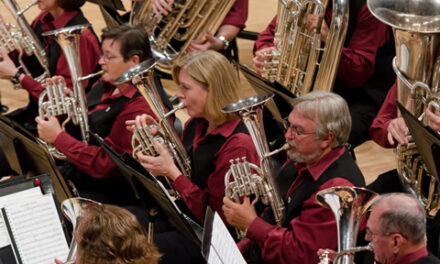Despite the unseasonably cool and wet evening, a sellout audience was present for an interesting and, some would say, “energetic” performance from the multiple Grammy Award winning guitarist and composer Pat Metheny and his cohorts. The concert was presented at the Carolina Theatre by Duke Performances.
It seems appropriate to quote directly from the excellent background notes in the program* for the concert: “With this incredible lineup of musicians – Chris Potter (woodwinds), Ben Williams (traditional acoustic and electric bass), Antonio Sanchez (drums), and the addition of multi-instrumentalist Giulio Carmassi – just about anything is possible.”
Let it be said that at the outset that there is no doubt that all of these musicians are well known and highly respected in the jazz community; this was clearly evident at various times during the two hours and forty minute performance (with no intermission!). The show – and it was a show – opened with a solo guitar introduction by the leader on his unique (4 necks, 2 sound holes and 42 strings “Pikasso”) instrument that enabled him to explore several tonal ranges simultaneously to great musical effect. “In addition to contributing his usual tenor and soprano saxophone skills, Chris Potter (was) featured on half a dozen woodwind instruments, while Ben Williams… often show(ed) off his arco bowing technique; drummer Antonio Sanchez (was) showcased throughout: as always Metheny’s preference, the drums (were) front and center”
Following his relatively restrained solo introduction on the Pikasso, Metheny was joined by Potter, Williams, and Sanchez in their more familiar roles in the Unity Group playing basically tunes composed by Metheny in the jazz-rock style, complete with solos and group improvisation that were executed with impressively complex technique and dynamics. Some of this involved the use of unusual time signatures, which in jazz date back to Dave Brubeck‘s group in the ’50s and ’60s (“Take Five,” “Blue Rondo a la Turk,” etc.) as well as the Don Elliot Orchestra and others. Particularly notable was Sanchez’s skill and musicianship in executing these rhythmic patterns in very melodic designs. Metheny’s music required a level of creativity that goes “… beyond the sonic limits of what a straight-ahead [jazz] quartet might invoke.” Other than the wide decibel levels “invoke(d)”, a critique of this approach might be that while the solos are interesting individually, there is a tendency for them to be overly technique oriented and unnecessarily repetitive and redundant at the expense of melody, especially in the ensemble portions that end up as a continuous cacophony; this can get tiresome, to say the least, especially after being seated for two hours and forty minutes. Free jazz has its limits!
The second portion of the program was devoted to the Unity Group’s most recent recording “Kin (<–– ––>)” (sic). Here the “show” revealed itself with the addition of multi-instrumentalist Garmassi, i.e., the stage set comprised of not only the players’ basic instruments but an array of electro-mechanical and electronic devices including a complete drum set hung from the ceiling, an electronically driven multi-mallet vibraphone, a similarly driven single mallet attached to a cymbal, plus various electronic sound and light emitting devices, all backed by a large projection screen (that rarely seemed to be projecting anything relevant) at the rear of the stage. According to the program notes these devices “…seem… to best capture Metheny’s new way of looking (sic!) at music….” This “weird stuff”, as he referred to it on stage, ” … cooks up a brew that incorporates … electronic dance music (that mimics) the sounds of the streets”. It seems difficult to imagine people actually “dancing” to this “stuff” in the streets or anywhere else for that matter! Having noted all of the above, this part of the program had some more thoughtful and subtle moments than simply New Age Jazz-on-Steroids more appropriate to a stadium of thousands rather than a provincial theatre seating a few hundred. There was a delightful section where Metheny played several duets with the individuals in the group; for this he used one or more of the several guitars that he played throughout the evening. His solo with Garmassi on the keyboard (who also sang) displayed a level of musicianship reminiscent of the great Brazilian classical (and jazz) guitarist Laurindo Almeida.
The Group’s not-unanticipated enthusiastic encore was a relatively sedate New Age “atmospheric” piece punctuated with some screeching guitar riffs and an actually quite mellow flute solo plus the usual interlude of cacophony with the final slowdown to an anticlimactic finish. “Just about anything is possible”. But is it relevant? The audience (of hundreds) loved it!
*I have quoted extensively from the excellent program notes in this review since they generally describe the attributes of the musicians in a factual and unbiased way.











